|
American Express Company, also known as AmEx, is an American multinational financial services corporation headquartered in Three World Financial Center, Manhattan, New York City, New York, United States. Founded in 1850, it is one of the 30 components of the Dow Jones Industrial Average. The company is best known for its credit card, charge card, and traveler's cheque businesses. Amex cards account for approximately 24% of the total dollar volume of credit card transactions in the US.
BusinessWeek and Interbrand ranked American Express as the 22nd most valuable brand in the world, estimating the brand to be worth US$14.97 billion. Fortune listed Amex as one of the top 20 Most Admired Companies in the World.
The company's logo, adopted in 1958, is a Roman Gladiator whose image appears on the company's travelers'
cheques and charge cards.
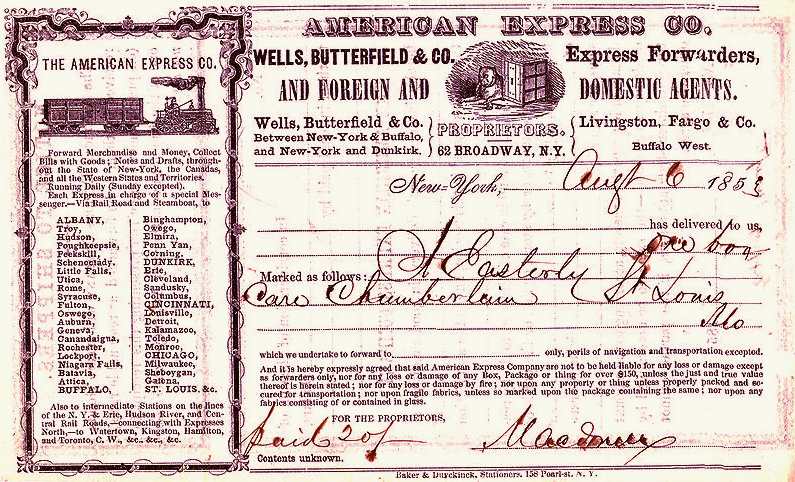
STARTUP
American Express was started as an express mail business in Buffalo, New York, in
1850. It was founded as a joint stock corporation by the merger of the express companies owned by Henry Wells (Wells & Company), William G. Fargo (Livingston, Fargo & Company), and John Warren Butterfield (Wells, Butterfield & Company, the successor earlier in 1850 of Butterfield, Wasson & Company). The same founders also started Wells Fargo & Co. in 1852 when Butterfield and other directors objected to the proposal that American Express extend its operations to California.
American Express first established its headquarters in a building at the intersection of Jay Street and Hudson Street in what was later called the Tribeca section of Manhattan. For years it enjoyed a virtual monopoly on the movement of express shipments (goods, securities, currency, etc.) throughout New York State. In 1874, American Express moved its headquarters to 65 Broadway in what was becoming the Financial District of Manhattan, a location it was to retain through two buildings.
BUILDINGS
n 1854, the American Express Co. purchased a lot on Vesey Street in New York City as the site for its stables. The company's first New York headquarters were in an
impressive marble Italianate palazzo at 55–61 Hudson Street between Thomas Street and Jay Street (1857–58, John Warren Ritch), which had a busy freight depot on the ground story with a spur line from the Hudson River Railroad. A stable was constructed nearby at 4–8 Hubert Street, between Hudson Street and Collister Street (1866–67, Ritch & Griffiths), five blocks north of the Hudson Street building.
The company prospered sufficiently that headquarters were moved in 1874 from the wholesale shipping district to the budding Financial District, and into rented offices in two five-story brownstone commercial buildings at 63 and 65 Broadway, between Exchange Alley and Rector Street, and between Broadway and Trinity Place that were owned by the Harmony family.
In 1880, American Express built a new warehouse behind the Broadway Building at 46 Trinity Place, between Exchange Alley and Rector Street. The designer is unknown, but it has a façade of brick arches that are redolent of pre-skyscraper New York. American Express has long been out of this building, but it still bears a terracotta seal with the American Express Eagle. In 1890–91 the company constructed a new ten-story building by Edward H. Kendall on the site of its former headquarters on Hudson Street.
By 1903, the company had assets of some $28 million, second only to the National City Bank of New York among financial institutions in the
city. To reflect this, the company purchased the Broadway buildings and site.
At the end of the Wells-Fargo reign in 1914, an aggressive new president, George Chadbourne Taylor (1868–1923), who had worked his way up through the company over the previous thirty years, decided to build a new headquarters. The old buildings, dubbed by the New York Times as "among the ancient landmarks" of lower Broadway, were inadequate for such a rapidly expanding concern. In March 1914, Renwick, Aspinwall & Tucker filed for the construction of a 32-story concrete-and steel-framed office tower in which all of the company's operations, then in four separate buildings, were to be consolidated. The building proposal of 1914 was abandoned, probably due to the war in Europe, but was resurrected two years later in a reduced form, at an estimated cost of $1 million.
The 21-story (plus basement), neo-classical, American Express Co. Building, was constructed in 1916–17 to the design of James L. Aspinwall, of the firm of Renwick, Aspinwall & Tucker, the successor to the architectural practice of the eminent James Renwick, Jr.. The building consolidated the two lots of the former buildings with a single address: 65 Broadway. This building was part of the "Express Row" section of lower Broadway at the time.
The concrete-and-steel-framed building has an H-shaped plan with tall slender wings arranged around central light courts, a type of plan employed from the 1880s through the 1910s to provide offices with maximum light and air. Faced in white brick and terra cotta above a granite base, both facades employ the tripartite composition of base-shaft-capital then popular for the articulation of skyscrapers, with a colonnaded base and upper portion. The famous American Express Eagle adorns the building twice: there is an asymmetric eagle on the lower arch, while a symmetric eagle adorns the arch atop the building. The Broadway entrance features a double-story Corinthian colonnade with large arched windows. The building completed the continuous masonry wall of its block-front poda nae and assisted in transforming Broadway into the "canyon" of neo-classical masonry office towers familiar to this day.
American Express sold this building in 1975, but retained travel services here. The building was also the headquarters over the years of other prominent firms, including investment bankers J.& W. Seligman & Co. (1940–74), the American Bureau of Shipping, a maritime concern (1977–86), and currently J.J. Kenny, and Standard & Poor's, who has renamed the building for itself.
FINANCIAL SERVICES
In 1882, American Express started its expansion in the area of financial services by launching a money order business to compete with the United States Post Office's money orders.
Sometime between 1888 and 1890, J. C. Fargo took a trip to Europe and returned frustrated and infuriated. Despite the fact that he was president of American Express and that he carried with him traditional letters of credit, he found it difficult to obtain cash anywhere except in major cities. Fargo went to Marcellus Flemming Berry and asked him to create a better solution than the traditional letter of credit. Berry introduced the American Express Traveler's Cheque which was launched in 1891 in denominations of $10, $20, $50, and $100.
Traveler's cheques established American Express as a truly international company. In 1914, at the outbreak of World War I, American Express offices in Europe were among the few companies to honor the letters of credit (issued by various banks) held by Americans in Europe, despite other financial institutions having refused to assist these stranded travelers.
RAILROADS & MONOPOLIES COMMISSION
American Express became one of the monopolies that President Theodore Roosevelt had the Interstate Commerce Commission investigate during his administration. The interest of the ICC was drawn to its strict control of the railroad express business. However, the solution did not come immediately to hand. The solution to this problem came as a coincidence to other problems during
World War
I.
During the winter of 1917, the US suffered a severe coal shortage and on December 26 President Woodrow Wilson commandeered the railroads on behalf of the US government to move US troops, their supplies, and coal. Treasury Secretary William Gibbs McAdoo was assigned the task of consolidating the railway lines for the war effort. All contracts between express companies and railroads were nullified and McAdoo proposed that all existing express companies be consolidated into a single company to serve the country's needs. This ended American Express's express business, and removed them from the ICC’s interest. The result was that a new company called the American Railway Express Agency formed in July 1918. The new entity took custody of all the pooled equipment and property of existing express companies (the largest share of which, 40%, came from American Express, who had owned the rights to the express business over 71,280 miles (114,710 km) of railroad lines, and had 10,000 offices, with over 30,000 employees). CHARGE CARD SERVICES
American Express executives discussed the possibility of launching a travel charge card as early as 1946, but it was not until Diners Club launched their card in March 1950 that American Express began to seriously consider the possibility. At the end of 1957, American Express CEO Ralph Reed decided to get into the card business, and by the launch date of October 1, 1958 public interest had become so significant that they issued 250,000 cards prior to the official launch date. The card was launched with an annual fee of $6, $1 higher than Diners Club, to be seen as a premium product. The first cards were paper, with the account number and cardmember's name typed. It was not until 1959 that American Express began issuing embossed ISO/IEC 7810 plastic cards, an industry first.
In 1966, American Express introduced the Gold Card and in 1984 the Platinum Card, clearly defining different market segments within its own business, a practice that has proliferated across a broad array of industries. The Platinum Card was billed as super-exclusive and had a $250 annual fee (it is currently $450). It was offered by invitation only to American Express customers with at least 2 years of tenure, significant spending, and excellent payment history; it is now open to applications on request.
In 1987, American Express introduced the Optima card, their first credit card product. Previously, all American Express cards had to be paid in full each month, but Optima allowed customers to carry a balance (the charge cards also now allow extended payment options on qualifying charges based on credit availability). Although American Express no longer accepts applications for the Optima brand of cards, since July 13, 2009, Optima cards are still listed on the American Express website, as a reference to existing members only. According to American Express, Optima accounts were not converted or closed. However, Blue from American Express has prevailed as the replacement for the original Optima style of credit card. Blue includes multiple benefits free of charge, unlike Optima, including the Membership Rewards program. In October 2012, The Consumer Financial Protection Bureau (CFPB) announced an enforcement action with orders requiring three American Express subsidiaries to refund an estimated $85 million to approximately 250,000 customers for illegal card practices. This action was the result of a multi-part federal investigation which found that at every stage of the consumer experience, from marketing to enrollment to payment to debt collection, American Express violated consumer protection laws. American Express did send letters to some previous customers: "We invite you to apply for the Optima Card from American Express. This opportunity is in connection with a settlement solicitation, which did not clearly disclose that a settlement could prevent you from being approved for a new account with us in the future. This is in response to an enforcement action by the Federal Deposit Insurance Corporation and Consumer Financial Protection Bureau regarding this issue. Your attached application will be approved unless we determine that you do not have the financial capacity to make the minimum payment on this new Optima Card account, or we receive the application after 04/25/2013."
In April 1992, American Express spun off its subsidiary, First Data Corp., in an IPO. Then, in October 1996, the company distributed the remaining majority of its holdings in First Data Corp., reducing its ownership to less than 5%.
In 1994, the Optima True Grace card was introduced. The card was unique in that it offered a grace period on all purchases whether a balance was carried on the card or not (as opposed to traditional revolving credit cards which charge interest on new purchases if so much as $1 was carried over). The card was discontinued a few years later; the now discontinued One from American Express card offered a similar feature called "Interest Protection."

THE BOSTON FEE PARTY
From early 1980s until the early 1990s, American Express was known for cutting its merchant fees (also known as a "discount rate") to merchants and restaurants if they accepted only American Express and no other credit or charge cards. This prompted competitors such as Visa and MasterCard to cry foul for a while as the tactics "locked" restaurants into American Express. The practice ended in 1991, as several restaurants in Boston started accepting and encouraging the use of Visa and MasterCard because of their far lower fees as compared to American Express' fees at the time (which were about 4% for each transaction versus around 1.2% at the time for Visa and MasterCard). A few even stopped accepting American Express credit and charge cards. The revolt, known as the "Boston Fee Party" (in reference to the Boston Tea Party), was orchestrated by a PR firm hired and paid by Discover Card. The campaign spread to over 250 restaurants across the United States, including restaurants in other cities such as New York City, Chicago, and Los Angeles. In response, American Express reduced its discount rate gradually to compete more effectively and add new merchants such as supermarkets and drugstores to its network. Many elements of the exclusive acceptance program were also phased out and American Express pursued other programs to effectively encourage businesses to add American Express cards to their existing list of payment options.
CABLE TV
American Express formed a joint venture with Warner Communications in 1979 called Warner-Amex Satellite Entertainment, which created MTV, Nickelodeon, and The Movie Channel. The partnership lasted only until 1984. The properties were sold to Viacom soon after.
Conversion to bank holding company
On November 10, 2008, during the financial crisis of 2008, the company won Federal Reserve System approval to convert to a bank holding company, making it eligible for government help under the Troubled Asset Relief Program. At that time, American Express had total consolidated assets of about $127 billion. In June 2009, $3.39 billion in TARP funds were repaid plus $74.4 million in dividend payments, and in July 2009 they ended their obligations under TARP by buying back $340 million in Treasury warrants.
UK CONTROVERSY
In November 2010 the UK division of American Express was cautioned by the Office of Fair Trading for the use of controversial charging orders against those in debt. The regulator said that the company was one of four companies who were encouraging customers to turn their unsecured credit card debts into a form of secured debt.
Loyalty acquisition
In March 2011, American Express completed a $685m purchase of Loyalty Partner, which operates the Payback loyalty program in Germany and
Poland, and the i-Mint loyalty program in India.
BUSINESS MODEL - Typical credit card business model
When a consumer makes a purchase using a credit or charge card, a small portion of the price is paid as a fee (known as the merchant discount), with the merchant keeping the remainder. There are typically three parties who split this fee amongst themselves:
* Acquiring bank: the bank which processes credit card transactions for a merchant, including crediting the merchant's account for the value charged to a credit card less all fees.
* Issuing bank: the bank which issues the consumer's credit card. This is the bank a consumer is responsible for repaying after making a credit card purchase. The issuer's share of the merchant discount is known as the interchange fee.
* Network: the link between acquiring banks and issuing banks. These banks have relationships with a network, rather than with each other, for fulfilling card purchases. This allows a card issued by a community bank in Peru to be used at a shop in South Africa, for instance, without requiring the banks to have a direct relationship with each other. The two largest networks in the world are Visa and MasterCard. American Express operates its own network.
The average merchant discount in the United States is 1.9%. Of this, approximately 0.1% goes to the acquirer, 1.7% to the issuer, and 0.09% to the network.
Most Prime and Superprime card issuers use the majority of their interchange revenue to fund loyalty programs like frequent flyer points and cash back, and hence their profit from card spending is small relative to the interest they earn from card lending.
CARD
PRODUCTS
American Express is best known for its iconic Green, Gold, and Platinum charge cards, and offers credit cards of similar color levels in most countries.
In the 1950s, American Express issued its first credit card, which caught on quickly in the booming postwar economy and signaled the company's transition to a wider consumer base. In 1966, the company issued its first
gold card, in an effort to cater to the upper echelon of business travel. Its platinum card debuted in 1984 and continues to be immensely popular as it is second in exclusivity only to the Centurion Card.
In 1999, American Express introduced the Centurion Card, often referred to as the "black card," which caters to an even more affluent and elite customer segment. The card was initially available only to select users of the Platinum card. The annual fee for the card is $2,500 (up from $1,000 at introduction) with an additional one-time initiation fee of $5,000. American Express created the card line amid rumors and urban legends in the 1980s that it produced an ultra-exclusive black card for elite users who could purchase anything with it.
American Express cards range between no annual fee (for Blue and many other consumer and business cards) and a $450 annual fee (for the Platinum card). Annual fees for the Green card start at $95 (first year free), while Gold card annual fees start at $125.
American Express has several co-branded credit cards, with most falling into one of three categories:
* Airlines: e.g., Aerolineas Argentinas, Air Canada, Air France, Alitalia, British Airways, Cathay Pacific, Delta Air Lines, JetBlue Airways, Qantas, Scandinavian Airlines, Singapore Airlines, Virgin Atlantic, among others.
* Hotels: e.g., Hilton Hotels. Starwood Hotels & Resorts Worldwide
* Retailers: e.g., Costco, David Jones, Holt Renfrew, Harrods, Macys, Bloomingdales, Lowe's, Mercedes Benz, and others.
Their card aimed at young adults is called Blue from American Express. A television media campaign for Blue adopted the 1979 UK Synthpop hit "Cars" by Gary Numan as its theme song. Based on a successful product for the European market, Blue had no annual fee, a rewards program, and a multi-functional onboard smart chip. A cashback version, "Blue Cash", quickly followed. Amex also targeted young adults with City Reward Cards that earn INSIDE Rewards points to eat, drink, and play at New York, Chicago and LA hot spots. American Express began phasing out the INSIDE cards in mid-2008, with no new applications being taken as of July 2008.
In 2005, American Express introduced Clear, advertised as the first credit card with no fees of any kind. Also in 2005, American Express introduced One, a credit card with a "Savings Accelerator Plan" that contributes 1% of eligible purchases into a High-Yield Savings Account insured by the Federal Deposit Insurance Corporation. Other cards introduced in 2005 included "The Knot" and "The Nest" Credit Cards from American Express, co-branded cards developed with the
wedding planning website theknot.com.
In 2006, the UK division of American Express joined the Product Red coalition and began to issue a Red Card. With each card member purchase the company contributes to causes through The Global Fund to Fight AIDS, Tuberculosis and Malaria to help African women and children suffering from HIV/AIDS, malaria, and other diseases.
In 2009, American Express introduced the ZYNC charge card. White in color, this card was created for people in their 20s and 30s. American Express is no longer taking applications for the ZYNC charge card.
In late 2012, American Express and Walmart announced the launch of Bluebird, a prepaid debit card similar to that of Green Dot. Bluebird is being touted as having lower fees than other prepaid debit cards with some of the benefits of traditional American Express cards, such as roadside assistance and identity theft protection. The card can also be used as a substitute to a traditional checking account. Unlike other such cards, Bluebird is FDIC-insured. FDIC backing means Bluebird accounts now have deposit insurance, check writing capabilities and customers can now have Social Security checks, military pay and other government benefits deposited directly into their accounts.
Card design
The company mascot, the Roman Gladiator or Centurion, appears at the center of the iconic Zync, Green, Gold, Platinum, and Centurion cards. The figure and his pose evoke classical antiquity. These cards also feature intricate border and background designs that read "American Express." The unique designs on these cards, especially the Green card, bear resemblance to those on United States Federal Reserve Notes, and enhance the image of the cardholder as an affluent and conspicuous consumer.
EXPRESSPAY
In 2005, American Express introduced ExpressPay, similar to MasterCard PayPass and Visa payWave. It is a contactless payment system based on wireless RFID, where transactions are completed by holding the credit card near a receiver at which point the debt is immediately added to the account. The card is not swiped and no PIN is entered. Many U.S. merchant and restaurant partners now offer ExpressPay, including Meijer, CVS/Pharmacy, Best Buy, Chevron Corporation, Noah's Bagels, and some McDonald's locations. Office Depot has implemented ExpressPay in all 1200 of its stores.
SMALL BUSINESS SERVICES (also known as American Express OPEN)
American Express offers various types of charge cards for small businesses to manage their expenses, and the company is also the largest provider of corporate cards.
In late 2007, the company announced the new Plum Card as the latest addition to their card line for small business
owners. The card provides a 1.5% early pay discount or up to two months to defer payment on purchases. The 1.5% discount is available for billing periods where the cardmember spends at least $5,000. The first 10,000 cards were issued to members on December 16, 2007.
In 2008, American Express made a decision to close all Business Line of Credit accounts. This decision was reached in tandem with the Federal Reserve's approval of American Express's request to become a Commercial Bank.
COMMERCIAL CARDS & SERVICES
American Express also offers a comprehensive range of cards designed to support mid-sized and large companies manage their travel and day-to-day operational expenses. The core product, the American Express Corporate Card is offered in over 40 countries, and a number of complementary products for specific types of spending are offered for special needs. Examples of these products include the Corporate Meeting Card, the Corporate Purchasing Card, and the Business Travel Account. Commercial Cards differ from Business Cards as they enable company liability (business cards are issued as extensions of credit to the company's owner). In addition, Commercial Cards offer a comprehensive suite of data and reporting solutions that help clients gain visibility and control over employee expenditures.
As part of supporting Corporate clients, American Express offers a number of online solutions delivered through the American Express @ Work website. From American Express @ Work, clients have access to program management capabilities, online statements, reporting and data integration products. Information @ Work, a reporting tool targeted at mid-size companies to give them quick and easy access to their employees' spend data; Customized Reporting is provided to larger clients who require more advanced analytics and data consolidation capabilities. American Express also provides data files to clients to power expense reporting and reconciliation tools.
In 2008, American Express acquired the Corporate Payment Services business of GE, which primarily focused on providing Purchasing Card solutions for large global clients. As part of the $1b+ transaction, American Express also added a new product, called V-Payment, to its product portfolio. V-Payment is unique in that it enables a tightly controlled, single-use card number for increased control.
Non-proprietary cards
In December 2000, American Express agreed to acquire the US$226 million credit card portfolio of Bank of Hawaii, then a division of Pacific Century Financial Corp. In January 2006, American Express sold its Bank of Hawaii card portfolio to Bank of America (MBNA). Bank of America will issue Visa and American Express cards under the Bank of Hawaii name.
Until 2004, Visa and MasterCard rules prohibited issuers of their cards from issuing American Express cards in the United States. This meant, as a practical matter, that U.S. banks could not issue American Express cards. These rules were struck down as a result of antitrust litigation brought by the U.S. Department of Justice, and are no longer in effect. In January 2004, American Express reached a deal to have its cards issued by a U.S. bank, MBNA America.
Initially decried by MasterCard executives as nothing but an "experiment", these cards were released in October 2004. Some said that the relationship was going to be threatened by MBNA's merger with Bank of America, a major Visa issuer and original developer of Visa (and its predecessor, BankAmericard). However, an agreement was reached between American Express and Bank of America on December 21, 2005. Under the terms of the agreement, Bank of America will own the customer loans and American Express will process the transactions. Also, American Express will dismiss Bank of America from its antitrust litigation against Visa, MasterCard, and a number of U.S. banks. Finally, both Bank of America and American Express also said an existing card-issuing partnership between MBNA and American Express will continue after the Bank of America-MBNA merger. The first card from the partnership, the no-annual-fee Bank of America Rewards American Express card, was released on June 30, 2006.
Since then, Citibank, GE Money, and USAA have also started issuing American Express cards. Citibank currently issues several American Express cards including an American Airlines AAdvantage co-branded card. In January 2006 Amex issued Dillard's American Express card in joint cooperation with GE Money, however, in Mar 2008 GE sold its card unit to Amex for $1.1bn in cash only deal. HSBC Bank USA is currently testing both HSBC-branded and Neiman Marcus co-branded American Express rewards credit cards, with a full rollout scheduled for late 2007 or early 2008. Also, UBS launched its Resource Card program for US Wealth Management clients issuing Visa Signature credit cards and American Express charge cards linked to their customers accounts and employing a single rewards program for the two cards. Fidelity operates a similar program, issuing both American Express and Visa Signature cards through FIA Card Services
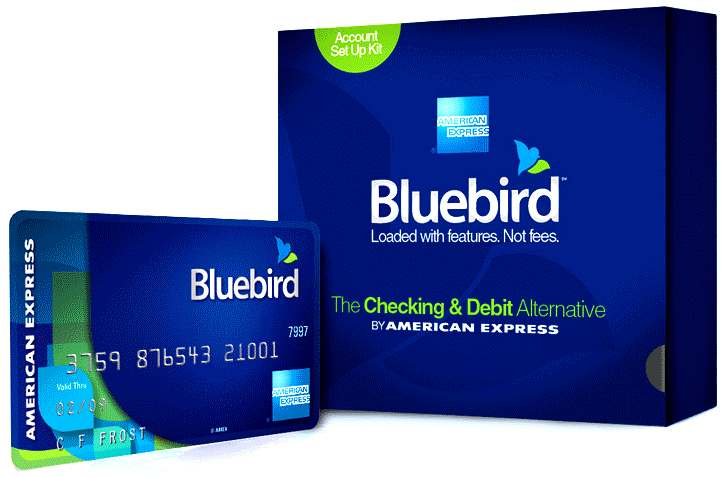
ADVERTISING
In 1975, David Ogilvy of Ogilvy & Mather developed the highly successful Don't Leave Home Without Them ad campaign for American Express Traveler's Cheques, featuring Oscar-award-winning actor Karl Malden. Karl Malden served as the public face of American Express Travelers Cheques for 25 years. In the UK the spokesman was instead the television personality Alan Whicker.
After Karl Malden's departure and as the card was promoted over the traveller's cheques, American Express continued to use celebrities, such as Mel Blanc and ballerina Cynthia Gregory. A typical ad for the American Express Card began with a celebrity asking viewers: "Do you know me?" Although he/she gave hints to his/her identity, the star's name was never mentioned except as imprinted on an American Express Card, after which announcer Peter Thomas told viewers how to apply for it. Each ad concluded with the celebrity reminding viewers: "Don't Leave Home Without It." The "Don't Leave Home Without It" slogan was revived in 2005 for the prepaid American Express Travelers Cheque Card.
These slogans have been parodied numerous times:
In The Sopranos episode, "Mr. & Mrs. John Sacrimoni Request...", Christopher Moltisanti concludes his sale of stolen credit card numbers to Middle Easterners with a quip: "Don't leave home without them!" This statement confuses the Middle Easterners, who are unfamiliar with the ad campaign.
The long-running PBS children's TV series Sesame Street parodied the "Do you know me?/Don't Leave Home Without It" ad campaigns with three skits involving a Muppet character holding a Grown-Up Friend's hand while crossing the street. One skit featured Forgetful Jones (performed by Richard Hunt) with Olivia (Alaina Reed Hall) as his Grown-Up Friend, a second featured Bert and Ernie (Frank Oz and Jim Henson respectively) with Gordon (Roscoe Orman) as their Grown-Up Friend, and the third featured Big Bird (Caroll Spinney) with Bob (Bob McGrath) as his Grown-Up Friend. All three skits ended with their names being embossed at the bottom of a card looking like an American Express card that had a big human left hand in the middle with the words "Grown-Up Friend's Hand" above it, and a voiceover saying "A Grown-Up Friend's Hand. Don't cross the street without it."
Another parody was seen on an episode of the CBS game show Press Your Luck, when the animated "Whammy Character" would give the "Do you know me?" tag line, followed by the display of an AmEx card-parody, which then had "WHAMMY" typed in on the bottom line of the card.
In the pilot episode of "Masquerade (TV series)", a KGB general says the line "I suppose you never leave home without it", to a KGB agent when he sees that agent's 'National American' card.
In a campaign speech during the 1984 Election, President Ronald Reagan said "If the big spenders get their way, they'll charge everything to your taxpayer's express card, and believe me, they never leave home without it."
In the final episode of The Dukes of Hazzard, Boss Hogg is shot at by a former associate, the bullet striking a wallet he had kept in his pocket and being lodged in several credit cards. Narrator Waylon Jennings takes note of the situation and says, "I bet he's glad he didn't leave home without them" (referring to his credit cards).
On the 1997 film Hercules during the song "Zero to Hero", the credit card is "Grecian Express".
The 1989 movie Major League also parodied the campaign. In one scene, in which every player is dressed in a tuxedo, the Cleveland Indians tell viewers of the film why every player carries the American Express Card with much of the explanation done one line at a time by players Jake Taylor (Tom Berenger), Eddie Harris (Chelcie Ross), Rick "Wild Thing" Vaughn (Charlie Sheen), Pedro Cerrano (Dennis Haysbert), and Roger Dorn (Corbin Bernsen), and Manager Lou Brown (James Gammon). The scene ends with Willie "Mays" Hayes (a tuxedo-clad Wesley Snipes) sliding into home plate in front of the rest of the team, holding up his card and saying to the viewers: "The American Express Card. Don't steal home without it."
In Batman & Robin Batman pulls out a Bat-Credit card and says he never leaves the cave without it.
Yakov Smirnoff's book cover, America on Six Rubles a Day ISBN 978-0-394-75523-6 depicts a Russian card with the slogan "Don't leave home."
American Express continues to use celebrities in their ads. Some notable examples include a late 1990s ad campaign with comedian Jerry Seinfeld, including the two 2004 webisodes in a series entitled "The Adventures of Seinfeld & Superman." In late 2004, American Express launched the "My life. My card." brand campaign (also by Ogilvy & Mather) featuring famous American Express cardmembers talking about their lives. The ads have featured actors Kate Winslet, Robert De Niro, Ken Watanabe and Tina Fey, Duke University basketball coach Mike Krzyzewski, fashion designer Collette Dinnigan, comedian and talk show hostess Ellen DeGeneres, golfer Tiger Woods, professional snowboarder Shaun White, tennis pros Venus Williams and Andy Roddick, Real Madrid manager José Mourinho, and film directors Martin Scorsese, Wes Anderson, M. Night Shyamalan and most recently singer Beyoncé Knowles. In 2007, a two-minute black-and-white ad entitled "Animals" starring Ellen DeGeneres won the Emmy Award for Outstanding Commercial.
Many American Express credit card ads feature a sample American Express Card with the name "C F Frost" on the front. This is not a fabricated name, as Charles F. Frost was an advertising executive from Ogilvy & Mather.
In addition, American Express was one of the earliest users of cause marketing, to great success. A 1983 promotion advertised that for each purchase made with an American Express Card, American Express would contribute one penny to the renovation of the Statue of Liberty. The campaign generated contributions of $1.7 million to the Statue of Liberty restoration project. What would soon capture the attention of marketing departments of major corporations was that the promotion generated approximately a 28% increase in American Express card usage by consumers.
Building on its earlier promotion, American Express later conducted a four-year Charge Against Hunger program, which generated approximately $22 million for a charity addressing poverty and hunger relief. In 2006, as part of Bono's Product Red, American Express launched the American Express Red Card with campaign starred by supermodel Gisele Bündchen. The card, currently available only in the United Kingdom, makes a donation to fight AIDS with every purchase made using the card. In May 2007, American Express launched an initiative called the Members Project. Cardholders were invited to submit ideas for projects and American Express is funding the winning (provide clean drinking water) project $2 million.
CORPORATE
GOVERNANCE The
current CEO is Ken I. Chenault took over leadership of American Express in 2001 from Harvey Golub, CEO from 1993 to 2001. Prior to that, the company was headed by James D. Robinson III from 1977 to 1993.
Other Key executives include: Douglas E. Buckminster: President, International Consumer and Global Network Services
James Bush: Executive Vice President, World Service
Kevin Cox: Executive Vice President, Human Resources
Edward P. Gilligan: Vice Chairman
William H. Glenn: President, Global Corporate Payments and Business Travel
Ash Gupta: Chief Risk Officer and President, Risk and Information Management
John D. Hayes: Executive Vice President and Chief Marketing Officer
Daniel T. Henry: Executive Vice President and Chief Financial Officer
Louise M. Parent: Executive Vice President and General Counsel
Thomas Schick: Executive Vice President, Corporate and External Affairs
Daniel H. Schulman: Group President, Enterprise Growth
Joshua G. Silverman: President, U.S. Consumer Services
Stephen J. Squeri: Group President, Global Corporate Services
Anré Williams: President, Global Merchant Services
Current members of the board of directors of American Express are:
Daniel F. Akerson: Managing Director of the Carlyle Group
Charlene Barshefsky: Former United States Trade Representative
Ursula M. Burns: President of Xerox Corporation
Kenneth I. Chenault: Chairman and CEO of American Express Co.
Peter Chernin: Former President and COO, News Corporation
Vernon E. Jordan, Jr.: Senior Managing Director with Lazard Freres & Co. LLC
Jan Leschly: CEO of Care Capital LLC
Richard C. Levin: President, Yale University
Richard A. McGinn: Former CEO of Lucent Technologies, Partner, RRE Ventures
Edward D. Miller: Former President and CEO of AXA SA
Frank P. Popoff: Former Chairman Chemical Financial Corp.
Steven S. Reinemund: Former Chairman and CEO, PepsiCo Inc.
Robert D. Walter: Chairman and CEO, Cardinal Health
Ronald A. Williams: Chairman and CEO, Aetna Inc.
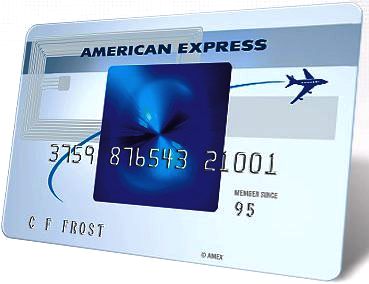
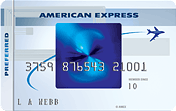
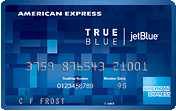
A
selection of the "Blue" cards provided by American Express
American
Express offer several versions of their Blue Card, each with particular
membership benefits.

The
American Express "Bluebird" prepaid credit card
AMEX CONTACTS
1-877-297-4438
8
am to midnight ET, 7 days

An
event aimed at matching startup business with investment bankers
AMEX
LINKS:
Personal
Cards
Credit
Cards
The
Platinum Cashback Credit Card
The
British Airways American Express® Credit Card
The
British Airways American Express® Premium Plus Card
The
Starwood Preferred Guest® Credit Card
The
Nectar Credit Card
Charge
Cards
The
Platinum Card®
The
Gold Card®
The
Harrods American Express® Card
Small
Business Cards
Credit
Cards
The
Nectar for Business Credit Card
Charge
Cards
The
Platinum Business Card
The
Gold Business Card
The
Basic Business Card
Card
Categories
Avios
Cashback
Cards
Charge
Cards
Credit
Cards
Premium
Cards
Retail
Rewards Cards
Rewards
Cards
Travel
Rewards Cards
Insurance
products from American Express
Travel
Insurance
Car
Insurance
Home
Insurance
Services
and Benefits from American Express
Services
Merchant
Services
Moving
Abroad?
External
Links http://en.wikipedia.org/wiki/American_Express https://www.americanexpress.com/uk/ http://bluesavings.americanexpress.com/#/ http://www.youngstartup.com/newengland2013/sponsors.php http://www.youngstartup.com/newengland2013/present.php http://www.youngstartup.com/newengland2013/overview.php http://www.premiercercle.com/sites/ipsummit/2013/paris2013/ www.ipsummit.info https://twitter.com/IPSummit
Young
startup sponsors Young
startup present Young
startup overview
MONEY
FINDER
|









